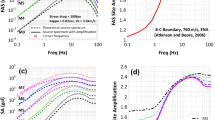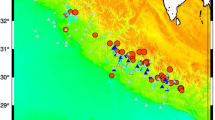Abstract
A new non-ergodic ground-motion model (GMM) for effective amplitude spectral (EAS) values for California is presented in this study. EAS, which is defined in Goulet et al. (Effective amplitude spectrum (eas) as a metric for ground motion modeling using fourier amplitudes, 2018), is a smoothed rotation-independent Fourier amplitude spectrum of the two horizontal components of an acceleration time history. The main motivation for developing a non-ergodic EAS GMM, rather than a spectral acceleration GMM, is that the scaling of EAS does not depend on spectral shape, and therefore, the more frequent small magnitude events can be used in the estimation of the non-ergodic terms. The model is developed using the California subset of the NGAWest2 dataset (Ancheta in PEER NGA-West2 database. Tech. rep., PEER, Berkeley, CA, 2013). The Bayless and Abrahamson (Bull Seismol Soc Am 109(5): 2088-2105, https://doi.org/10.1785/0120190077, 2019b) (BA18) ergodic EAS GMM was used as backbone to constrain the average source, path, and site scaling. The non-ergodic GMM is formulated as a Bayesian hierarchical model: the non-ergodic source and site terms are modeled as spatially varying coefficients following the approach of Landwehr et al. (Bull Seismol Soc Am 106(6):2574-2583. https://doi.org/10.1785/0120160118, 2016), and the non-ergodic path effects are captured by the cell-specific anelastic attenuation attenuation following the approach of Dawood and Rodriguez-Marek (Bull Seismol Soc Am 103(2B):1360-1372, https://doi.org/10.1785/0120120125, 2013). Close to stations and past events, the mean values of the non-ergodic terms deviate from zero to capture the systematic effects and their epistemic uncertainty is small. In areas with sparse data, the epistemic uncertainty of the non-ergodic terms is large, as the systematic effects cannot be determined. The non-ergodic total aleatory standard deviation is approximately 30 to \(40\%\) smaller than the total aleatory standard deviation of BA18. This reduction in the aleatory variability has a significant impact on hazard calculations at large return periods. The epistemic uncertainty of the ground motion predictions is small in areas close to stations and past events.


















Similar content being viewed by others
Availability of data and material
Non applicable.
Code availability
The are python scripts for the non-ergodic regressions are provided at: https://github.com/glavrentiadis/NonErgodicGMM_public
References
Abrahamson NA, Atkinson GM, Boore DM, Bozorgnia Y, Campbell KW, Chiou BS, Idriss IM, Silva WJ, Youngs RR (2008) Comparisons of the NGA ground-motion relations. Earthquake Spectra 24(1):45–66. https://doi.org/10.1193/1.2924363
Abrahamson NA, Silva WJ, Kamai R (2014) Summary of the ASK14 ground motion relation for active crustal regions. Earthquake Spectra 30(3):1025–1055. https://doi.org/10.1193/070913EQS198M
Abrahamson NA, Kuehn NM, Walling M, Landwehr N (2019) Probabilistic Seismic Hazard Analysis in California Using Nonergodic Ground Motion Models. Bulletin of the Seismological Society of America 109(4), 1235–1249, https://doi.org/10.1785/0120190030, https://pubs.geoscienceworld.org/ssa/bssa/article/109/4/1235/571959/
Akkar S, Ça\(\check{{\rm g}}\)nan Z (2010) A local ground-motion predictive model for Turkey, and its comparison with other regional and global ground-motion models. Bulletin of the Seismological Society of America 100(6):2978–2995. https://doi.org/10.1785/0120090367
Al Atik L, Abrahamson NA, Bommer JJ, Scherbaum F, Cotton F, Kuehn NM (2010) The Variability of Ground-Motion Prediction Models and Its Components. Seismol Res Lett 81(5), 794–801, https://doi.org/10.1785/gssrl.81.5.794, https://pubs.geoscienceworld.org/srl/article/81/5/794-801/143735
Ancheta TD, Darragh RB, Stewart JP, Seyhan E, Silva WJ, Chiou BS, Wooddell KE, Graves RW, Kottke AR, Boore DM, Kishida T, Donahue JL (2013) PEER NGA-West2 database. Tech. rep, PEER, Berkeley, CA
Ancheta TD, Darragh RB, Stewart JP, Seyhan E, Silva WJ, Chiou BS, Wooddell KE, Graves RW, Kottke AR, Boore DM, Kishida T, Donahue JL (2014) NGA-West2 database. Earthquake Spectra 30(3):989–1005. https://doi.org/10.1193/070913EQS197M
Anderson JG, Brune JN (1999) Probabilistic seismic hazard analysis without the ergodic assumption. Seismol Res Lett 70(1):19–28. https://doi.org/10.1785/gssrl.70.1.19
Bayless J, Abrahamson NA (2018) Evaluation of the interperiod correlation of ground-motion simulations. Bull Seismol Soc Am 108(6):3413–3430. https://doi.org/10.1785/0120180095
Bayless J, Abrahamson NA (2019a) An Empirical Model for the Interfrequency Correlation of Epsilon for Fourier Amplitude Spectra. Bull Seismol Soc Am 109(3):1058–1070. https://doi.org/10.1785/0120180238
Bayless J, Abrahamson NA (2019b) Summary of the BA18 Ground-Motion Model for Fourier Amplitude Spectra for Crustal Earthquakes in California. Bulletin of the Seismological Society of America 109(5), 2088–2105, https://doi.org/10.1785/0120190077, https://pubs.geoscienceworld.org/ssa/bssa/article/109/5/2088/573508/Summary-of-the-BA18-GroundMotion-Model-for-Fourier
Bindi D, Pacor F, Luzi L, Puglia R, Massa M, Ameri G, Paolucci R (2011) Ground motion prediction equations derived from the Italian strong motion database. Bull Earthq Eng 9(6):1899–1920. https://doi.org/10.1007/s10518-011-9313-z
Bishop CM (2006) Pattern Recognition and Machine Learning. Springer, New York
Bommer JJ, Coppersmith KJ, Coppersmith RT, Hanson KL, Mangongolo A, Neveling J, Rathje EM, Rodriguez-Marek A, Scherbaum F, Shelembe R, Stafford PJ, Strasser FO (2015) A SSHAC level 3 probabilistic seismic hazard analysis for a new-build nuclear site in South Africa. Earthquake Spectra 31(2):661–698. https://doi.org/10.1193/060913EQS145M
Boore DM (1983) Stochastic simulation of high-frequency ground motions based on seismological models of the radiated spectra. Bulletin of the Seismological Society of America 73(6):1865–1894, http://www.bssaonline.org/cgi/content/abstract/73/6A/1865
Bora SS, Scherbaum F, Kuehn NM, Stafford PJ, Edwards B (2015) Development of a response spectral ground-motion prediction equation (GMPE) for seismic-hazard analysis from empirical fourier spectral and duration models. Bull Seismol Soc Am 105(4):2192–2218. https://doi.org/10.1785/0120140297
Bora SS, Scherbaum F, Kuehn N, Stafford P (2016) On the relationship between fourier and response spectra: Implications for the adjustment of empirical ground-motion prediction equations (GMPEs). Bull Seismol Soc Am 106(3):1235–1253. https://doi.org/10.1785/0120150129
Bora SS, Cotton F, Scherbaum F (2019) NGA-West2 empirical fourier and duration models to generate adjustable response spectra. Earthquake Spectra 55(1):61–93. https://doi.org/10.1193/110317EQS228M
Bozorgnia Y, Abrahamson NA, Al Atik L, Ancheta TD, Atkinson GM, Baker JW, Baltay AS, Boore DM, Campbell KW, Chiou BS, Darragh R, Day S, Donahue J, Graves RW, Gregor N, Hanks TC, Idriss IM, Kamai R, Kishida T, Kottke AR, Mahin SA, Rezaeian S, Rowshandel B, Seyhan E, Shahi S, Shantz T, Silva WJ, Spudich P, Stewart JP, Watson-Lamprey J, Wooddell K, Youngs RR (2014) NGA-West2 research project. Earthquake Spectra 30(3):973–987. https://doi.org/10.1193/072113EQS209M
Bragato PL, Slejko D (2005) Empirical ground-motion attenuation relations for the eastern Alps in the magnitude range 2.5–6.3. Bull Seismol Soc Am 95(1):252–276. https://doi.org/10.1785/0120030231
Brune JN (1970) Tectonic stress and the spectra of seismic shear waves from earthquakes. J Geophys Res 75(26):4997–5009. https://doi.org/10.1029/jb075i026p04997
Brune JN (1971) Correction to Tectonic stress and the spectra of seismic shear waves from earthquakes. J Geophys Res 76(20):1971
Bussas M, Sawade C, Kuehn NM, Scheffer T, Landwehr N (2017) Varying-coefficient models for geospatial transfer learning. Mach Learn 106(9–10):1419–1440. https://doi.org/10.1007/s10994-017-5639-3
Chiou BS, Youngs RR (2014) Update of the Chiou and Youngs NGA Model for the Average Horizontal Component of Peak Ground Motion and Response Spectra. Earthquake Spectra 30(3), 1117–1153, https://doi.org/10.1193/072813EQS219M, http://peer.berkeley.edu/lifelines/nga_docs/jul_10_06/Chiou_Youngs_NGA_2006.pdfhttp://earthquakespectra.org/doi/10.1193/072813EQS219M
Chiou BS, Youngs R, Abrahamson NA, Addo K (2010) Ground-motion attenuation model for small-to-moderate shallow crustal earthquakes in California and its implications on regionalization of ground-motion prediction models. Earthquake Spectra 26(4):907–926. https://doi.org/10.1193/1.3479930
Coppersmith K, Bommer J, Hanson K, Unruh J, Coppersmith R, Wolf L, Youngs R, Rodriguez-Marek A, Al Atik L, Toro G, et al. (2014) Hanford sitewide probabilistic seismic hazard analysis. PNNL-23361 Pacific Northwest National Laboratory, Richland Washington http://www hanford gov/page cfm/OfficialDocuments/HSPSHA
Danciu L, Tselentis GA (2007) Engineering Ground-Motion Parameters Attenuation Relationships for Greece. Bull Seismol Soc Am 97(1B), 162–183, https://doi.org/10.1785/0120050087, https://pubs.geoscienceworld.org/bssa/article/97/1B/162-183/146558
Dawood HM, Rodriguez-Marek A (2013) A Method for including path effects in ground-motion prediction equations: An example using the Mw 9.0 Tohoku earthquake aftershocks. Bull Seismol Soc Am 103(2B):1360–1372, https://doi.org/10.1785/0120120125
Douglas J, Akkar S, Ameri G, Bard PY, Bindi D, Bommer JJ, Bora SS, Cotton F, Derras B, Hermkes M, Kuehn NM, Luzi L, Massa M, Pacor F, Riggelsen C, Sandıkkaya MA, Scherbaum F, Stafford PJ, Traversa P (2014) Comparisons among the five ground-motion models developed using RESORCE for the prediction of response spectral accelerations due to earthquakes in Europe and the Middle East. Bull Earthq Eng 12(1):341–358. https://doi.org/10.1007/s10518-013-9522-8
Eberhart-Phillips D (2016) Northern California seismic attenuation: 3D Qp and Qs models. Bull Seismol Soc Am 106(6):2558–2573. https://doi.org/10.1785/0120160060
Elzhov TV, Mullen KM, Spiess AN, Bolker B (2016) minpack.lm: R Interface to the Levenberg-Marquardt Nonlinear Least-Squares Algorithm Found in MINPACK, Plus Support for Bounds. https://CRAN.R-project.org/package=minpack.lm, r package version 1.2-1
Goulet C, Kottke A, Boore D, Bozorgnia Y, Hollenback J, Kishida T, Der Kiureghian A, Ktenidou O, Kuehn N, Rathje E, et al. (2018) Effective amplitude spectrum (eas) as a metric for ground motion modeling using fourier amplitudes. In: 2018 Seismology of the Americas Meeting
Hiemer S, Scherbaum F, Roessler D, Kuehn NM (2011) Determination of 0 and Rock Site from Records of the 2008/2009 Earthquake Swarm in Western Bohemia. Seismol Res Lett 82(3), 387–393, https://doi.org/10.1785/gssrl.82.3.387, https://pubs.geoscienceworld.org/srl/article/82/3/387-393/143819
Kuehn NM, Abrahamson NA, Walling MA (2019) Incorporating Nonergodic Path Effects into the NGA-West2 Ground-Motion Prediction Equations. Bull Seismol Soc Am 109(2), 575–585, https://doi.org/10.1785/0120180260, https://pubs.geoscienceworld.org/ssa/bssa/article/569193/Incorporating-Nonergodic-Path-Effects-into-the
Kuehn NM, Bozorgnia Y, Campbell KW, Gregor N (2020) Partially Non-Ergodic Ground-Motion Model for Subduction Regions using the NGA-Subduction Database. Tech. Rep, September, PEER
Kutner MH, Nachtsheim CJ, Neter J, Li W, et al. (2005) Applied linear statistical models, vol 5. McGraw-Hill Irwin New York
Landwehr N, Kuehn NM, Scheffer T, Abrahamson NA (2016) A nonergodic ground-motion model for California with spatially varying coefficients. Bull Seismol Soc Am 106(6):2574–2583. https://doi.org/10.1785/0120160118
Lin PS, Chiou BS, Abrahamson NA, Walling M, Lee CT, Cheng CT (2011) Repeatable source, site, and path effects on the standard deviation for empirical ground-motion prediction models. Bull Seismol Soc Am 101(5):2281–2295. https://doi.org/10.1785/0120090312
Phillips WS, Mayeda KM, Malagnini L (2014) How to Invert Multi-Band, Regional Phase Amplitudes for 2-D Attenuation and Source Parameters: Tests Using the USArray. Pure Appl Geophys 171(3–5):469–484. https://doi.org/10.1007/s00024-013-0646-1
R Core Team (2020) R: A Language and Environment for Statistical Computing. R Foundation for Statistical Computing, Vienna, Austria, https://www.R-project.org/
Rasmussen CE, Williams CKI (2006) Gaussian processes for machine learning. The MIT Press, Cambridge, MA, USA 38:715–719
Simpson D, Rue H, Riebler A, Martins TG, Sørbye SH (2017) Penalising model component complexity: A principled, practical approach to constructing priors. Stat Sci 32(1):1–28. https://doi.org/10.1214/16-STS576
Stafford PJ, Rodriguez-Marek A, Edwards B, Kruiver PP, Bommer JJ (2017) Scenario dependence of linear site-effect factors for short-period response spectral ordinates. Bull Seismol Soc Am 107(6):2859–2872. https://doi.org/10.1785/0120170084
Stan Development Team (2019) The Stan Core Library. http://mc-stan.org/, version 2.25.0
Tromans IJ, Aldama-Bustos G, Douglas J, Lessi-Cheimariou A, Hunt S, Daví M, Musson RMW, Garrard G, Strasser FO, Robertson C (2019) Probabilistic seismic hazard assessment for a new-build nuclear power plant site in the UK. Bull Earthq Eng 17(1):1–36. https://doi.org/10.1007/s10518-018-0441-6
Yagoda-Biran G, Anderson JG, Miyake H, Koketsu K (2015) Between-event variance for large repeating earthquakes. Bull Seismol Soc Am 105(4):2023–2040. https://doi.org/10.1785/0120140196
Acknowledgements
This work was partially supported by the PG&E Geosciences Department Long-Term Seismic Program. The authors also thankful to the three anonymous reviewers for constructive comments that helped to improve the final article.
Funding
This work was partially funded by the Pacific Earthquake Engineering Research Center (PEER) Transportation Systems Research Program and by the PG&E Geosciences Department Long-Term Seismic Program.
Author information
Authors and Affiliations
Corresponding author
Ethics declarations
Conflict of interest
The authors declare that they have no conflict of interest.
Ethics approval
Non applicable.
Consent to participate
Non applicable.
Consent for publication
Non applicable.
Additional information
Publisher's Note
Springer Nature remains neutral with regard to jurisdictional claims in published maps and institutional affiliations.
Supplementary Information
Below is the link to the electronic supplementary material.
Rights and permissions
About this article
Cite this article
Lavrentiadis, G., Abrahamson, N.A. & Kuehn, N.M. A non-ergodic effective amplitude ground-motion model for California. Bull Earthquake Eng 21, 5233–5264 (2023). https://doi.org/10.1007/s10518-021-01206-w
Received:
Accepted:
Published:
Issue Date:
DOI: https://doi.org/10.1007/s10518-021-01206-w




